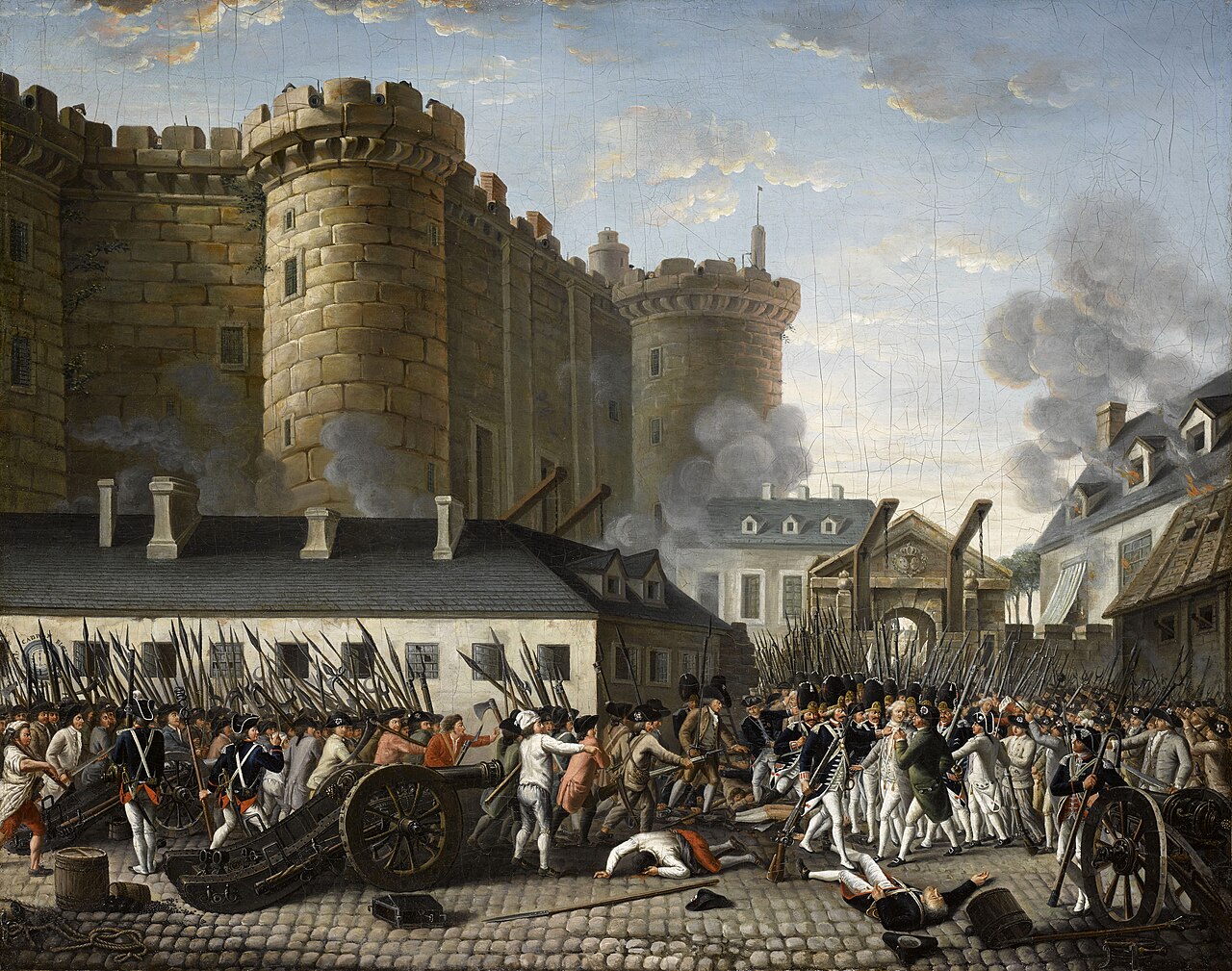
The Beginning and Glorious Days of the Bastille Castle in Paris
The Bastille, one of the most famous landmarks in French history, had a long and complex past before its eventual destruction in 1789. While today it is remembered primarily as a symbol of tyranny and oppression, the Bastille’s early days were quite different. Originally constructed as a fortress for the defense of Paris, it played a crucial role in the city’s protection and later became a place of royal significance.
The Construction and Early Purpose
The Bastille was built during the late 14th century, under the reign of King Charles V. At the time, France was engaged in the Hundred Years’ War with England, and the security of Paris was a major concern. To protect the eastern entrance to the city, Charles V ordered the construction of a fortress near the Saint-Antoine gate. The work began around 1370 and was completed by 1383.
Initially, the Bastille was a relatively modest structure, but it quickly expanded into a formidable fortress with eight massive towers, thick stone walls, and a deep moat. It was designed to withstand prolonged sieges and attacks, providing a strong defensive position for the city. During its early years, the Bastille was seen as a source of security rather than fear.
A Symbol of Royal Power and Prestige
Beyond its military function, the Bastille also became an important symbol of royal authority. By the 15th century, it served as a residence for high-ranking officials and even some members of the nobility. It housed valuable state treasures, including royal documents and the king’s personal wealth.
The fortress gained further prominence under King Louis XI (1461–1483), who began using it as a state prison for the first time. However, during this period, it was not yet considered a place of cruelty and oppression. The prisoners were usually political enemies, noblemen, or those involved in conspiracies, and many of them were treated with a degree of comfort.
Under the rule of Francis I and Henry IV in the 16th and early 17th centuries, the Bastille continued to serve multiple roles. It was not only a prison but also a safe place for storing gunpowder, weapons, and state records. The fortress had a strategic location in Paris, ensuring it remained a key part of the city’s infrastructure.
The Storming of the Bastille
The storming of the Bastille on July 14, 1789, stands as one of the most significant events in world history. This momentous occasion marked the beginning of the French Revolution, a movement that dismantled the monarchy and reshaped the political landscape of France and Europe. The Bastille, a medieval fortress located in Paris, was more than just a prison, it was a symbol of royal tyranny, a representation of oppression, and a focal point of the people’s growing discontent with the absolute rule of King Louis XVI. This article explores why the Bastille was so hated, the dramatic events that led to its storming, and what remains of it today.
The Bastille and Its Infamy
The Bastille was originally built in the 14th century as a fortress to protect Paris from English invasion during the Hundred Years’ War. However, by the 17th and 18th centuries, it had been repurposed as a state prison, where political dissidents, writers, and other individuals considered dangerous to the monarchy were incarcerated. Unlike ordinary prisons, where trials and due process determined an inmate’s fate, the Bastille operated under the king’s arbitrary authority, prisoners could be detained indefinitely without trial based solely on royal orders known as “lettres de cachet.”
The Bastille’s notoriety stemmed from its association with tyranny and its secretive nature. Although conditions inside were not necessarily as horrific as depicted by revolutionaries, the secrecy surrounding the prison, the stories of unjust imprisonment, and its very function as a tool of royal despotism made it a focal point of public outrage. For the common people, the Bastille embodied everything they despised about the monarchy, oppression, injustice, and unchecked power.
The Causes Leading to the Storming
The late 18th century was a period of political and economic turmoil in France. Several factors contributed to the growing dissatisfaction that culminated in the storming of the Bastille:
- Economic Hardship – France faced a severe financial crisis due to years of war, including the costly American Revolution, and mismanagement of resources. The government was deeply in debt, and the burden of taxation fell disproportionately on the common people while the aristocracy and clergy enjoyed privileges.
- Food Shortages – A series of poor harvests in the 1780s led to skyrocketing bread prices, causing starvation and suffering among the lower classes. Bread riots became common, and frustration with the monarchy’s inability to provide relief grew.
- Political Unrest – The Estates-General, a legislative assembly representing the three social classes, convened in May 1789 for the first time in 175 years. The Third Estate (commoners) was determined to push for political reforms and soon declared itself the National Assembly, challenging the king’s authority.
- The Dismissal of Jacques Necker – King Louis XVI dismissed his finance minister, Jacques Necker, on July 11, 1789. Necker was seen as sympathetic to the common people, and his removal triggered widespread anger and protests in Paris.
The Storming of the Bastille: July 14, 1789
On the morning of July 14, thousands of Parisians gathered in the streets, demanding weapons to defend themselves against the king’s troops. They first seized muskets and cannons from the Hôtel des Invalides, but they lacked gunpowder. Knowing that the Bastille stored a large supply, the crowd marched toward the fortress.
When the crowd reached the Bastille, they demanded its governor, Bernard-René de Launay, to surrender the fortress and hand over the gunpowder. Initially, negotiations took place, but tensions escalated when shots were fired, possibly by accident. This ignited a full-scale battle between the revolutionaries and the Bastille’s defenders. After hours of fighting, the crowd managed to breach the outer defenses and stormed the prison.
Governor de Launay, realizing the situation was hopeless, surrendered. However, the enraged mob dragged him outside, beat him, and eventually executed him. His head was paraded on a pike through the streets of Paris, a gruesome symbol of the revolution’s fervor.
The fall of the Bastille was a watershed moment. It demonstrated that the people could defy the king and take power into their own hands. In response to the uprising, King Louis XVI reluctantly recognized the authority of the newly formed National Assembly, effectively marking the end of absolute monarchy in France.
Why Was the Bastille Hated?
The Bastille was despised for several reasons:
- Symbol of Tyranny – The prison represented the arbitrary power of the monarchy. People could be imprisoned without trial, often for trivial reasons, or for expressing dissenting political opinions.
- Mysterious and Fearsome Reputation – The secrecy surrounding the prison fueled exaggerated stories of inhumane conditions and torture, making it a feared institution even beyond its actual function.
- Association with Elite Privilege – While commoners suffered, the nobility and clergy were often exempt from similar punishments. The Bastille became a representation of the unfair and unjust social hierarchy in France.
- Focus of Revolutionary Sentiment – The prison was a convenient target for the revolutionaries because its destruction would symbolize the end of oppression and the dawn of a new era of liberty and equality.
After its fall, the Bastille was systematically demolished. The process was carried out by workers led by Pierre-François Palloy, who turned the rubble into souvenirs, including small models of the prison. These artifacts were distributed throughout France as symbols of victory over tyranny.
The storming of the Bastille inspired the revolutionary movement across the country. It led to the abolition of feudal privileges and eventually the execution of King Louis XVI and Queen Marie Antoinette. The revolution paved the way for democratic governance in France and influenced other movements for liberty worldwide.
The Bastille’s Golden Days
During the 17th century, the Bastille reached the height of its importance. Under King Louis XIV, it became more established as a prison, but at the same time, it retained an air of prestige. Some prisoners enjoyed luxurious conditions, receiving books, fine food, and even personal servants.
The fortress was also used to imprison writers and intellectuals whose works were considered dangerous to the monarchy, such as Voltaire. Yet, despite its growing reputation as a place of imprisonment, the Bastille remained a powerful symbol of royal strength and order.
For much of its existence, the Bastille was seen as a grand and necessary institution. It was only later, as abuses of power became more widespread, that the castle turned into a hated symbol of tyranny.
Can You Still See the Bastille Today?
Today, the Bastille itself no longer exists, as it was completely dismantled. However, traces of its history remain in Paris:
- Place de la Bastille – The site where the Bastille once stood is now a large public square, home to the July Column, which commemorates the July Revolution of 1830.
- Bastille Metro Station – The remains of some original walls of the Bastille can be seen inside the metro station beneath the square.
- Musée Carnavalet – This museum in Paris houses artifacts and models of the Bastille, providing historical context and insight into its role in the French Revolution.
- Rue Saint-Antoine – A few scattered stones from the Bastille can still be found in certain locations around Paris, including along Rue Saint-Antoine.
The storming of the Bastille was a destruction of a prison, it was a powerful statement against tyranny and injustice. The fall of the Bastille on July 14, 1789, set the stage for revolutionary change, transforming France and leaving a lasting legacy on global politics. Today, while the fortress itself no longer stands, its memory lives on, celebrated every year on Bastille Day (Fête Nationale), a national holiday in France that honors the spirit of liberty, equality, and fraternity. image/wikipedia




